Get unique, complex parts easily. No matter your requirements, Chaoyi Spring creates hard-to-produce coil springs and wire forms.
Let us help you create the custom wire form you need, from S-hooks and J-hooks to utility hooks and more.
We work closely with customers across a wide range of industries, helping them design and manufacture made-to-order parts.
Why choose Chaoyi Spring? We prioritize customer-focused collaboration, modern equipment and the latest technology to make your parts per print.
Find the information and guidance you need, from measuring a spring to learning about materials, placing an order and much more.
Your garage door's torsion springs are the unsung heroes of your home's security and convenience. They're the powerful coils responsible for lifting and lowering your heavy door with ease. But


Your garage door's torsion springs are the unsung heroes of your home's security and convenience. They're the powerful coils responsible for lifting and lowering your heavy door with ease. But like any mechanical part, they have a lifespan and can pose a serious safety hazard if not properly sized and maintained. This guide delves into the world of garage door torsion springs, helping you understand their sizes, how to identify them, and why it's crucial to get it right for a smooth-operating and safe garage door.

Garage door torsion springs are essential components that provide the force needed to lift and lower your door. They're located above the door, typically on a shaft, and work by storing energy as the door is closed, then releasing that energy to open it. When functioning properly, they make opening and closing your garage door effortless. However, improperly sized or worn-out springs can lead to a host of problems, including:
It's crucial to recognize the importance of understanding torsion springs and getting them right for your specific garage door.
Garage door torsion springs come in different sizes, each tailored to the weight and dimensions of the door. Here's what you need to know about understanding the language of these springs:
Don't worry if all these technical terms seem daunting. The key is to understand that these factors all work together to determine the spring's strength and suitability for your garage door.
The best way to determine the correct torsion spring size for your garage door is to consult a professional garage door technician. However, if you're looking to learn more or do some preliminary research, here's a general guideline for garage door torsion spring sizes. This information is a starting point and should not be considered a definitive replacement for professional advice.
Before diving into specific size charts, it's helpful to grasp some fundamental principles.
It's important to note that spring sizes can vary depending on the manufacturer and the specific model of your garage door.
This chart serves as a general guide and should not be used as a definitive replacement for professional advice. It's crucial to consult a qualified technician to determine the exact spring sizes needed for your garage door.
| Garage Door Weight (lbs) | Spring Diameter (inches) | Spring Length (inches) | Spring Wind (turns) |
|---|---|---|---|
| Up to 100 lbs | .250 | 20 | 10 |
| 100 - 150 lbs | .312 | 22 | 12 |
| 150 - 200 lbs | .375 | 24 | 14 |
| 200 - 250 lbs | .437 | 26 | 16 |
| 250 - 300 lbs | .500 | 28 | 18 |
Remember, this is a simplified illustration for understanding. Factors like the door's width, height, material, and the presence of additional features (such as an automatic opener) can influence the actual spring size needed.
If you're looking to find the size of your existing torsion springs, here are some tips:
Remember, working with garage door springs can be dangerous. If you're unsure about anything, always consult a qualified technician.
Garage door torsion springs have a finite lifespan, typically around 10,000 cycles (openings and closings). Here are some signs that your springs may need replacing:
If you suspect your springs are nearing the end of their life, contact a professional garage door technician. They can inspect the springs and recommend replacement if needed.
Garage door torsion springs are under immense tension and can pose serious safety hazards if not handled correctly. Here are some important precautions:
Understanding garage door torsion spring sizes is essential for ensuring a smooth-operating, safe, and reliable garage door. Whether you're buying a new door, replacing springs, or simply learning more about your current system, this guide provides valuable insights. Remember, when in doubt, always consult a qualified garage door technician. Their expertise ensures your safety and the optimal performance of your garage door for years to come.
Garage door torsion springs are crucial for a properly functioning and safe garage door. Understanding their sizes and knowing when to replace them is essential for peace of mind. Always prioritize safety and consult a professional technician for any repairs or replacements. By taking care of your torsion springs, you're investing in the longevity and security of your home.
Browse some of the custom wire forms and springs that we manufacture. Don’t see what you need? We specialize in made-to-order products that meet your application requirements.
Visit Our GalleryNeed a custom wire form or coil spring? We make it work. Fill out the contact form and a representative will respond within 1 business day. If you have a PDF or CAD file, you can submit to request a quote.